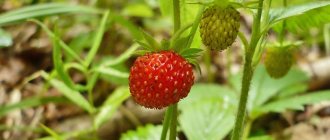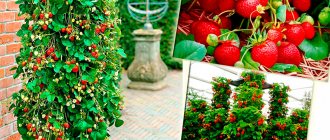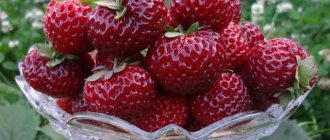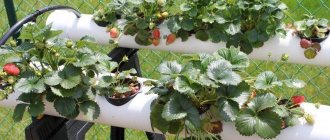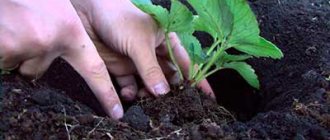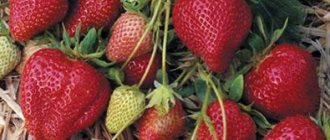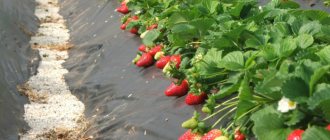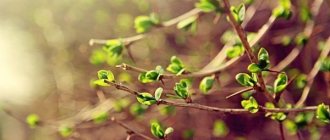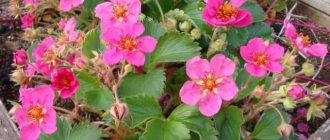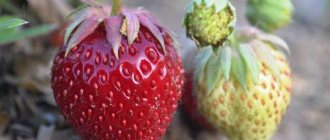In Russia, Victoria is the name given to all garden strawberries. For ordinary people, it makes no difference that in front of them is the real Victoria or her relative of another species. Much more important for the common consumer is the size, juiciness and aroma of the fruit. However, an experienced gardener can say with confidence where Victoria is and where another variety of strawberry is.
The Victoria berry variety has been grown by gardeners for about 200 years. It is believed that the culture was developed in England and named after Queen Victoria, who reigned at that time. This variety of strawberries appeared in Russia thanks to Peter I. Initially, the variety was called “British Queen”.
Description of the variety
People who have little knowledge of breeding can easily confuse ordinary strawberries with Victoria - they look about the same. But with a detailed analysis, the difference can still be noticed.
There are differences between the berries both in appearance and taste. In general, we can say that Victoria is similar in appearance to ordinary strawberries, but tastes like strawberries. The Victoria variety was the result of crossing garden and forest strawberries.
On a note! The fruits of the resulting crop are large in size and have a noticeably pronounced aroma.
Appearance
Victoria strawberry bushes have some distinctive features:
- large size sockets;
- large powerful leaf plate;
- leaf color – dark green, shape – triple;
- the fibrous root system goes underground 15-20 cm;
- shoots on which several daughter rosettes are formed have the ability to take root;
- an abundance of white flowers appears in late May-early June.
Ovaries are formed in large quantities, which is why the crop is considered high-yielding
The berries begin to ripen in the second summer month - July.
Productivity and fruit characteristics
The volume of fruiting of Victoria depends on the place of its planting, climatic conditions, intensity of care and age. The largest harvest comes from rosettes that are 2-3 years old. On bushes 4 and 5 years old, the number of berries is noticeably reduced - the beds need to be updated.
When describing the variety, one can also note:
- the fruits are large and fleshy;
- the average weight of one berry is 25-30 g, some specimens reach 50 g;
- the surface of the fruit is bright red, in cross section – pale pink;
- Victoria's taste is sweet and rich, with a slight sourness;
- sugar is present, its volume does not exceed 9%.
Victoria fruits are in demand in the food industry and in home cooking. This popularity is explained by the high taste qualities of the product.
Strawberries. Strawberry is a nut or berry and other interesting facts
Strawberries are the most common berry, found in almost every garden plot. Its story begins in South America, from where it spread throughout the world. This culture has a lot of useful properties and is used not only in cooking, but also in cosmetology. Many people wonder what strawberries are: a berry or a nut? To answer this, you need to carefully study the plant.
Description of culture
Strawberries got their name from their spherical shape. The root "club" means "round". This hybrid is much larger than its closest relative, the strawberry, which, like strawberries, is a false berry.
Strawberries have a very unusual pedigree. It is believed that it appeared due to the hybridization of wild strawberries with eastern strawberries. This plant grew in European forests more than 60 thousand years ago, which suggests that it even managed to survive the Ice Age. Its trace can be found in Medieval England, France and Germany. It is known for certain that wild strawberries were known to the ancient Romans, who included the berry in their diet.
Wild strawberries are found in the same places as wild strawberries. Currently, new varieties of this crop have been developed, which makes it possible to grow it even in the north. Under snow cover, frost-resistant varieties can survive temperatures below -35°C.
Most people classify strawberries as berries, but according to the scientific definition, they are nuts.
From a botanical point of view, this crop is a multi-nut crop, since small yellow seeds - nuts - are located on the juicy pulp. It is worth understanding that nuts are different from nuts. Real nuts are characterized by a hard shell with an edible part underneath. They have nothing in common with strawberry nuts, since to form strawberry fruits, not only the ovary, but also the receptacle appears.
It turns out that strawberries are not a representative of the nut crop, but belong to false berries, that is, to many nuts.
Difficulties in classification
From a scientific point of view, many fruits and berries familiar to us belong to other types of crops. This is due to the fact that the designation of various fruits appeared many centuries ago, even before botanists found an exact definition for each plant. It is believed that the berries are small spherical fruits with juicy pulp and grow on small bushes. However, the classification is a more in-depth definition.
Botanists have found that the berry can be distinguished from other fruits due to its three-layer composition. The top layer is the peel, the fleshy layer is in the middle, and the seeds are located inside. For example, according to this definition, the well-known grape is not a fruit, but a berry.
Strawberries and wild strawberries are a type of fruit called "multinut" because the seeds are located on the surface of the receptacle. They differ from achenes in that the nuts are formed not in the lower ovary, but on the surface of the fruit. Despite the scientific definition, strawberries are not required to be called a nut. Botanical classification does not prevent this crop from remaining a berry.
We are accustomed to classifying various plants in the usual way. Modern categorization consists of many nuances that are difficult for the average consumer to understand. Scientists have long been trying to bring order to the classification of cultures into one class or another, but such work can take an indefinite number of years.
It turns out that the fruits that we are accustomed to eating are difficult to attribute to a specific class. In order to correctly classify a particular plant, it is necessary to study the culture from different angles. But it is already known for certain that strawberries are not a berry from a botanical point of view, but are classified as multi-nuts.
Unusual Features
Strawberries are known to almost every person, but few people really know everything about this amazing plant. As it turned out earlier, the fruits of this crop are not berries. What else is interesting about strawberries?
- In fact, the plant that is grown in garden plots is not a strawberry. Its real name is “garden strawberry”, and it was formed by crossing Virginia strawberries and Chilean strawberries. The difference between strawberries and wild strawberries is only in the larger size of the fruit.
- Large-fruited strawberries are considered the only plant in the world whose seeds are located on the receptacle. On average, one fruit contains about 180 nuts.
- Scientists have found that strawberries surpass humans in the number of genes. According to recent studies, it has been proven that garden strawberries have 35 thousand genes, while humans are carriers of only 25 thousand genes.
- The most interesting thing is that strawberries contain more vitamin C than lemon. Per 100 g of fresh product there are 60 mg of ascorbic acid. For an adult, this dose is enough to meet the daily requirement for vitamin C.
Positive traits
Strawberries Victoria are very easy to care for. In addition, it gives a large and fragrant harvest. A remontant variety can bear fruit several times a season – until the onset of cold weather.
Reproducing Victoria is not that difficult.
Numerous shoots are easily separated from the mother bush and take root well in a new place
Flowers of both sexes - male and female - can appear on one bush. This factor increases the plant’s chances of pollination, which is why the bushes have abundant yields.
Such different berry plants
Although berry plants have many similarities, there are also differences between them. And everyone must make their choice in favor of one or the other themselves. But maybe you don’t need to choose, but simply diversify their use. But let’s figure out how strawberries differ from strawberries and Victoria:
- Landing. Strawberry bushes are planted in sunny areas, and nutmeg berries in the shade.
- Productivity. Strawberries are less productive.
- Berry size. Victoria strawberries have large fruits, while strawberries have small ones weighing from 2 to 5 grams.
- Appearance. Strawberries are brighter, more uniform and rich in flavor. The color of strawberries is uneven from light pink to purple.
- Aroma. Muscat strawberries have a richer flavor.
- Taste of berries. Victoria and strawberries have sweeter fruits.
- Frost resistance. Strawberries are tall, strawberries are weakly resistant and require mulching of the soil.
Benefit
The beneficial properties of Victoria are, first of all, the restoration of the body.
Medicinal properties
The berry is recommended to be consumed for pathologies:
Strawberry variety Queen
- of cardio-vascular system;
- diseases of the gastrointestinal tract;
- violation of water-salt balance;
- dysfunction of the digestive system.
In addition to the above, strawberries strengthen bone tissue and prevent the appearance of cholesterol plaques in the bloodstream. Regular consumption of dried and crushed berries reduces the risk of developing cancer to a minimum.
Red fruits help improve memory. Therefore, berries are strongly recommended for use by elderly people who suffer from partial or complete memory loss.
The English variety of the crop perfectly fights inflammatory processes. According to scientific experiments, it was proven that people who ate more than 15 Victoria berries per day during a cold period recovered their health 3 times faster.
Among the beneficial substances and microelements that make up the berries, you can find vitamins A and C. They are responsible for the functioning of the visual organ. A sufficient amount of substances can prevent such dangerous eye diseases as glaucoma, night blindness, premature aging of the retina, and cataracts.
Many pages can be devoted to the healing properties of Victoria. One thing is for sure - the berry is very beneficial for health, especially for older citizens.
Victoria for beauty
The fruits contain a special substance – anthocyanin. Plant antioxidants easily cope with extra pounds. At home, you can use recipes in which strawberries are the basis. Problem weight will go away quickly and forever.
Victoria is very useful for losing weight
Strawberry berries contain ellagic acid. This substance is a natural antioxidant. It can protect skin cells from damage. With regular consumption of berries, fine wrinkles on the face are smoothed out, deep wrinkles become less noticeable.
There is enough fiber in strawberries. But it contains very few calories. Judging by the numerous reviews found on the Internet, all this ensures uninterrupted bowel function and eliminates constipation.
Vitamin content:
| Vitamin C | 20 mg |
| Vitamin E | 0.8 mg |
| Vitamin B3 | 0.3 mg |
| Vitamin A | 0.03 mg |
| Vitamin B1 | 0.03 mg |
| Vitamin B6 | 0.06 mg |
Growing conditions
Plants can be planted 2 times a year - in spring and in the second half of summer. In order for Victoria to grow well and delight her with the harvest, she needs to create certain conditions.
For a strawberry bed, a flat, sunny area protected from the winds with sandy loam soil is suitable. When planning spring planting, the soil must be prepared in the fall. For summer planting, the soil is prepared 1.5-2 months earlier.
Landing
Preparation includes:
- Digging
- Weed removal
- Fertilizer application (wood ash, compost or humus)
- Formation of beds. It should be high if it is close to the surface of groundwater, low if there is no groundwater. The bushes are planted in an even row with an interval of 25-35 cm , the distance between rows is 50 cm
Seedlings are planted in prepared moistened holes, watered abundantly, and after 15-20 days fertilizing is done.
To protect against weeds, pests, and drying out, the soil around the plants is covered . This can be agrofibre, mulching film, mowed grass, straw.
The ground around the beds can be covered with dark agrofibre
The next step is caring for the planted plants; it consists of:
- Timely watering. It is better to do this once every 7 days with settled water by sprinkling until flowering begins when flowers appear under the bushes.
- Weeding
- Loosening
- There should be four fertilizers: 1st in the spring, 2nd during flowering, 3rd when the fruit is filling, 4th after harvesting.
To protect against sulfur or black rot, spotting, powdery mildew, before flowering, it is necessary to treat Victoria with a solution of potassium permanganate, copper oxychloride or a 1% solution of Bordeaux mixture.
Harm
Everything is good in moderation. And even such a seemingly harmless berry as Victoria can be harmful to human health.
Typically, strawberries are well tolerated by the body, but there are still some contraindications for consumption.
The berries should not be consumed by small children and nursing mothers - there is a high risk that the baby will develop an allergy to the red fruit
For adults who are prone to food allergies, eating Victoria strawberries may also be contraindicated. The treat contains protein that can cause negative reactions. Those citizens who react strongly to birch pollen and apples are especially susceptible. The clinical picture is manifested by the appearance of a rash, increased itching, runny nose, coughing and sneezing.
Strawberries have a diuretic effect. That is why it is so persistently recommended for hypertensive patients. After all, as you know, diuretics reduce blood pressure. Still, people who suffer from kidney failure need to be careful. In addition, berries should be discarded if a person is taking a course of Enapril tablets - in combination with strawberries, this drug can cause difficulties in the functioning of the kidneys.
Reviews
Katerina, Moscow Victoria berry is the strawberry of my childhood. This is an old variety that still grows in our garden. This is my favorite berry: tasty, beautiful, fruitful. We eat it fresh, do not make jam. We especially love it with sour cream or cream.
Andrey, Nizhny Novgorod Victoria has been growing with me for a long time, I’m not going to disturb it, because I’m happy with everything. In the first year after planting, the harvest is meager, in the second and especially in the third - a very good harvest, in the fourth - it falls and the berries become smaller. At the beginning of the season, the berry is large, but sour, and at the end it becomes smaller, but very sweet.
Alevtina, Kolomna This garden plant makes me happy every year. The berry is large, fragrant, very tasty, tender. It propagates very easily. Excellent strawberries, every year we simply overeat with them as a family and stock up on vitamins. There are also disadvantages - it is poorly transported and stored.
What is Victoria?
There are several versions of the origin of such an interesting name. The first says that the name was received from Queen Victoria, during whose reign berry gardens were laid out at Buckingham Palace. The second legend is this: the variety was bred in Holland and brought to Russia by Peter the Great. When the Tsar asked the sailors at the port what the berries were called, they shouted the name “Victoria”. The fruits are a type of pineapple strawberry - a close relative of the large-fruited garden variety that we talked about above. Nobody knows for sure!
We also recommend: Differences between oregano and basil
